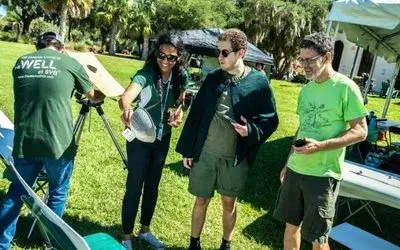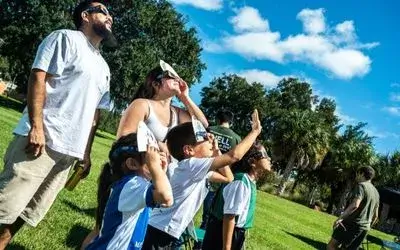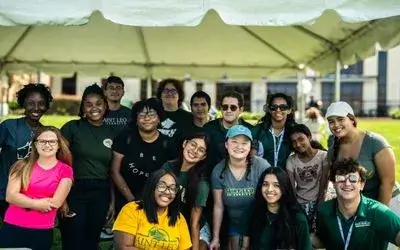For Dr. Harsha Perera, Saturday’s eclipse brought the opportunity to share a love of science and astronomy not only with Saint Leo University students, faculty, and staff, but also with the community. On October 14, the Saint Leo University Astronomy Club hosted “The Great American Solar Eclipse” event in the Bowl at University Campus.
Perera, assistant professor of physics/physical sciences and the club advisor, and undergraduate student Gregory Connelly, served as NASA Partner Eclipse Ambassadors.
“I was so excited when I first heard about the solar eclipses coming our way,” Perera said.
“I saw a partial eclipse when I was a kid, but didn’t know much about it. Back in the day, it was only the local news channels giving away the information on how to see it safely, but if you missed the news time, you wouldn’t know. As a physicist — an astrophysicist to be exact — I thought it was my responsibility as an educator to spread the word and educate our own community about these amazing and rare celestial events.”
Perera learned about a program conducted by the Astronomical Society of the Pacific (ASP) called “NASA Partner Eclipse Ambassadors - preparing communities off the path.” The partnership consists of an amateur astronomer (Perera in this case) and one undergraduate student (Connelly is Saint Leo’s representative). The partnership will be valid for one year, 2023-2024, which consists of two solar eclipses – an annular eclipse in October and a total eclipse in April.
“We participated in a three-week training course with amateur astronomers and students around the country,” Connelly said of the preparation for the big event. “The course taught us how to engage the public with eclipse science, how to make science an inclusive environment for unrepresented individuals in STEM (science, technology, engineering, and math), and the correct way to accommodate individuals’ different views and opinions. It also involved learning event-planning skills that we could use to captivate the public.”
One of the ways they captivated the public was by hosting a free event on October 7 at the Hugh Embry Library in Dade City, FL, near University Campus. “We had a perfect crowd for our first event; most of them were school-aged children who were home-schooling,” Perera said. “It was such an overwhelming joy to work with those kids.”
And Saint Leo student “Juan Contreras Jimenez was instrumental in helping to translate for Spanish speakers,” added Connelly, a biology-biomedical and health sciences major.
The event at the library was a warm-up for the “big event” — the annular eclipse on October 14. Those attending were able to decorate their own solar eclipse glasses, enjoy treats and refreshments, and learn about the science of the eclipse.
“Through our event on October 14, we were able to show and explain how eclipses happen using demonstration kits, why we see only partial eclipses, where can you see the complete annular eclipse, what it means by the annular eclipse — the ‘ring of fire,’ eclipse projection using binoculars —even the sunspots were visible, and we also gave away solar glasses to the crowd to enjoy the eclipse with their own eyes,” Perera said. “We had a great turnout and the crowd consisted of school-aged children to the elderly, who appreciated the rare wonder of our nature together with us equally.”
These celestial events are rare and maybe a once-in-a-lifetime experience for many, she said. Most importantly, everyone must know how to view the solar eclipse safely. “Since we are directly looking at the sun, if proper safety guidelines are not followed, one may even lose eyesight,” Perera said. “This was the most important information to provide to the general public. We also provided alternate ways such as pinhole projectors to see the eclipse safely when solar viewing glasses are not available.”
For Perera, it was a wonderful experience to host. “Sharing the ‘wow’ moment with everyone regardless of age is a lifetime experience for me, and it is contagious!”
Teaching science in a friendly and inviting way to the public is a very important task, Connelly said. “The public views science as challenging. And it can sometimes be viewed as dry or harsh. Presenting science in a fun way, such as a solar eclipse, can lead to the younger participants building a foundation that can grow into a career or lifelong passion.
“A solar eclipse is the perfect opportunity to accomplish this goal as you can physically witness the phenomenon, and it is a pretty fantastic and rare experience,” he added.
What’s Next
Saint Leo’s Astronomy Club is planning two more events for the April 8, 2024, total eclipse with one being held at the New River Library in Wesley Chapel, FL, and the other at University Campus. In addition, the club has been invited by an elementary school teacher to make presentations on astronomy in her classroom.
The Astronomy Club also plans to host the St. Petersburg Astronomy Club on campus for a "Star Party," visit the Kennedy Space Center in Cape Canaveral, FL, and go on a trip to an observatory.
For more information, email harsha.perera@saintleo.edu.



